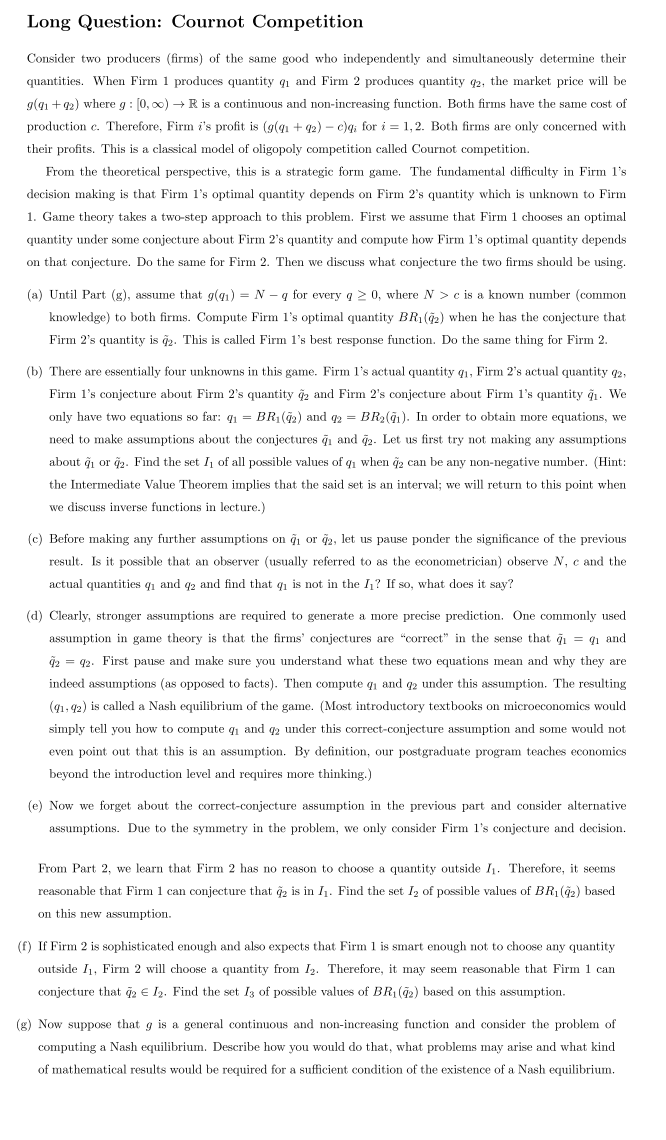
Long Question: Cournot Competition Consider two producers (firms) of the same good who independently and simultaneously determine their quantities. When Firm 1 produces quantity 91 and Firm 2 produces quantity 92, the market price will be 9(91+2) where g : [0,00) + R is a continuous and non-increasing function. Both firms have the same cost of production c. Therefore, Firm i's profit is (g(91 +92) - c) for i = 1,2. Both firms are only concerned with their profits. This is a classical model of oligopoly competition called Cournot competition. From the theoretical perspective, this is a strategic form game. The fundamental difficulty in Firm 1's decision making is that Firm l's optimal quantity depends on Firm 2's quantity which is unknown to Firm 1. Game theory takes a two-step approach to this problem. First we assume that Firm 1 chooses an optimal quantity under some conjecture about Firm 2's quantity and compute how Firm l's optimal quantity depends on that conjecture. Do the same for Firm 2. Then we discuss what conjecture the two firms should be using. (a) Until Part (g), assume that g(91) = N - q for every q > 0, where N >c is a known number common knowledge) to both firms. Compute Firm l's optimal quantity BR (92) when he has the conjecture that Firm 2's quantity is 02. This is called Firm l's best response function. Do the same thing for Firm 2. (b) There are essentially four unknowns in this game. Firm 1's actual quantity 01, Firm 2's actual quantity 02, Firm l's conjecture about Firm 2's quantity z and Firm 2's conjecture about Firm l's quantity 1. We only have two equations so far: 41 = BR: (02) and q2 = BR (1). In order to obtain more equations, we need to make assumptions about the conjectures 71 and 72. Let us first try not making any assumptions about i or 2. Find the set I of all possible values of q when Q2 be any non-negative number. (Hint: the Intermediate Value Theorem implies that the said set is an interval; we will return to this point when we discuss inverse functions in lecture.) (c) Before making any further assumptions on i or 02, let us pause ponder the significance of the previous result. Is it possible that an observer (usually referred to as the econometrician) observe N. c and the actual quantities 41 and 42 and find that qi is not in the 1,? If so, what does it say? (d) Clearly, stronger assumptions are required to generate a more precise prediction. One commonly used assumption in game theory is that the firms' conjectures are "correct" in the sense that g1 = 91 and 92 = 42. First pause and make sure you understand what these two equations mean and why they are indeed assumptions (as opposed to facts). Then compute q1 and 2 under this assumption. The resulting (21,42) is called a Nash equilibrium of the game. (Most introductory textbooks on microeconomics would simply tell you how to compute qi and q2 under this correct-conjecture assumption and some would not even point out that this is an assumption. By definition, our postgraduate program teaches economics beyond the introduction level and requires more thinking.) (e) Now we forget about the correct-conjecture assumption in the previous part and consider alternative assumptions. Due to the symmetry in the problem, we only consider Firm l's conjecture and decision. From Part 2, we learn that Firm 2 has no reason to choose a quantity outside 11. Therefore, it seems reasonable that Firm 1 can conjecture that is in 11. Find the set 12 of possible values of BR1 (62) based on this new assumption. (f) If Firm 2 is sophisticated enough and also expects that Firm 1 is smart enough not to choose any quantity outside 11, Firm 2 will choose a quantity from 19. Therefore, it may seem reasonable that Firm 1 can conjecture that 72 12. Find the set 13 of possible values of BR1 (72) based on this assumption. (8) Now suppose that g is a general continuous and non-increasing function and consider the problem of computing a Nash equilibrium. Describe how you would do that, what problems may arise and what kind of mathematical results would be required for a sufficient condition of the existence of a Nash equilibrium, Long Question: Cournot Competition Consider two producers (firms) of the same good who independently and simultaneously determine their quantities. When Firm 1 produces quantity 91 and Firm 2 produces quantity 92, the market price will be 9(91+2) where g : [0,00) + R is a continuous and non-increasing function. Both firms have the same cost of production c. Therefore, Firm i's profit is (g(91 +92) - c) for i = 1,2. Both firms are only concerned with their profits. This is a classical model of oligopoly competition called Cournot competition. From the theoretical perspective, this is a strategic form game. The fundamental difficulty in Firm 1's decision making is that Firm l's optimal quantity depends on Firm 2's quantity which is unknown to Firm 1. Game theory takes a two-step approach to this problem. First we assume that Firm 1 chooses an optimal quantity under some conjecture about Firm 2's quantity and compute how Firm l's optimal quantity depends on that conjecture. Do the same for Firm 2. Then we discuss what conjecture the two firms should be using. (a) Until Part (g), assume that g(91) = N - q for every q > 0, where N >c is a known number common knowledge) to both firms. Compute Firm l's optimal quantity BR (92) when he has the conjecture that Firm 2's quantity is 02. This is called Firm l's best response function. Do the same thing for Firm 2. (b) There are essentially four unknowns in this game. Firm 1's actual quantity 01, Firm 2's actual quantity 02, Firm l's conjecture about Firm 2's quantity z and Firm 2's conjecture about Firm l's quantity 1. We only have two equations so far: 41 = BR: (02) and q2 = BR (1). In order to obtain more equations, we need to make assumptions about the conjectures 71 and 72. Let us first try not making any assumptions about i or 2. Find the set I of all possible values of q when Q2 be any non-negative number. (Hint: the Intermediate Value Theorem implies that the said set is an interval; we will return to this point when we discuss inverse functions in lecture.) (c) Before making any further assumptions on i or 02, let us pause ponder the significance of the previous result. Is it possible that an observer (usually referred to as the econometrician) observe N. c and the actual quantities 41 and 42 and find that qi is not in the 1,? If so, what does it say? (d) Clearly, stronger assumptions are required to generate a more precise prediction. One commonly used assumption in game theory is that the firms' conjectures are "correct" in the sense that g1 = 91 and 92 = 42. First pause and make sure you understand what these two equations mean and why they are indeed assumptions (as opposed to facts). Then compute q1 and 2 under this assumption. The resulting (21,42) is called a Nash equilibrium of the game. (Most introductory textbooks on microeconomics would simply tell you how to compute qi and q2 under this correct-conjecture assumption and some would not even point out that this is an assumption. By definition, our postgraduate program teaches economics beyond the introduction level and requires more thinking.) (e) Now we forget about the correct-conjecture assumption in the previous part and consider alternative assumptions. Due to the symmetry in the problem, we only consider Firm l's conjecture and decision. From Part 2, we learn that Firm 2 has no reason to choose a quantity outside 11. Therefore, it seems reasonable that Firm 1 can conjecture that is in 11. Find the set 12 of possible values of BR1 (62) based on this new assumption. (f) If Firm 2 is sophisticated enough and also expects that Firm 1 is smart enough not to choose any quantity outside 11, Firm 2 will choose a quantity from 19. Therefore, it may seem reasonable that Firm 1 can conjecture that 72 12. Find the set 13 of possible values of BR1 (72) based on this assumption. (8) Now suppose that g is a general continuous and non-increasing function and consider the problem of computing a Nash equilibrium. Describe how you would do that, what problems may arise and what kind of mathematical results would be required for a sufficient condition of the existence of a Nash equilibrium







